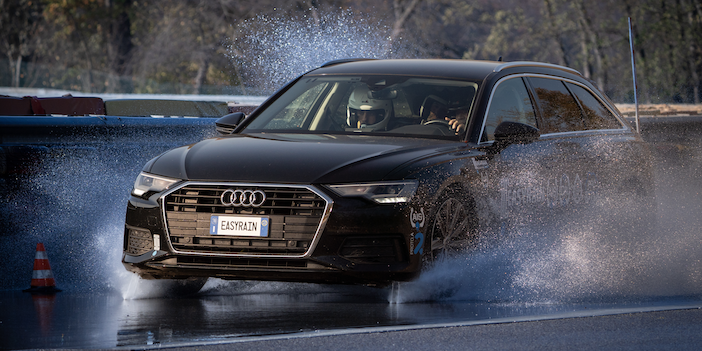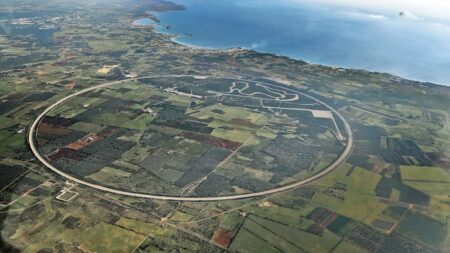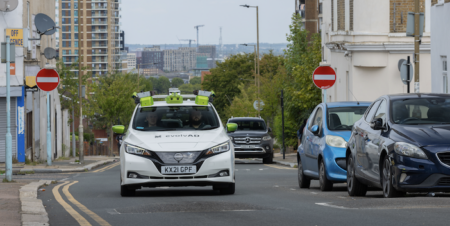Following a series of assessments of its technology at test events in November 2022, when carmakers got behind the wheel of proof-of-concept vehicles, Easyrain is now moving its AIS anti-aquaplaning system and DAI detection software into the industrialisation stage.
Along with technologies engineered for safety in wet and aquaplaning conditions, the Italian startup is developing algorithms to detect loss of tyre contact on snow, ice and slippery road surfaces. Together with these new algorithms, the company has begun testing a software designed to detect any incorrect symmetry in a vehicle set-up, which can improve driving safety, reduce CO2 and avoid unusual tire wear. The company believes that this software can activate new safety functions and will eventually lead to a new generation of ADAS systems, capable of modulating the level of driving assistance according to the condition of the road surface.
You can watch lab tests of the technology at THIS PAGE.
Easyrain is also working on an evolution of its AIS hardware system, which is expected to debut on the market in mid-2026. Billed as the first active system to counter aquaplaning, the company is moving it towards industrialisation, with new components being studied with a view to reducing weight, size and cost. This component work is being carried out with Tier-1 suppliers, both in the development stage and as Easyrain moves to the production process.
Looking a little further ahead, Easyrain has begun preliminary studies on a hardware product (known internally as Project-X) that is designed to further enhance road safety on low-grip surfaces. The goal is to restore grip not just on very wet surfaces, but also in the event of loss of control on ice and snow, which the company says could help achieve the European goal of zero deaths on the road by 2050.
OEM feedback
The innovations were assessed by experts from carmakers at an ‘Easyrain Experience’ event in November 2022 at the Applus+ IDIADA proving ground in Spain. The test drives with OEMs showcased the system’s effectiveness on various types of cars, including sedans, station wagons and SUVs. According to Easyrain, the participants provided positive feedback, with the AIS anti-aquaplaning system compared in significance to the introduction of stability and braking control systems.
Further work with OEMs includes technical discussions about how to integrate the systems into vehicles. The levels of product integration range from detection algorithms that activate new functions or improve assisted driving functions, up to the complete package including DAI, AIS and ERC, bringing together software, hardware and cloud.
The Easyrain Cloud (ERC), currently under development, stores data from the DAI and algorithms; this information allows the refinement of the algorithms and predictive warning services in the event of wet asphalt, aquaplaning, icy surfaces, potholes, or wear of vehicle components. ERC could also be used to update in real time a new database dedicated to road safety, within which private companies, agencies and public bodies can find information about any dangers on the road network.
The AIS, DAI and ERC technologies have been integrated into the Italdesign Climb-E, an autonomous vehicle concept that was presented at the 2023 Consumer Electronics Show in Las Vegas.
Giovanni Blandina, Easyrain’s founder and CEO said of the advances in the technology: “We were alone at the beginning, but today we feel the enthusiasm of the carmakers who have tested our technologies and are asking us to bring them into production. Easyrain had an exciting 2022, marked by the success of the new version of AIS and DAI. Let’s head into 2023 with concentration: we have a duty and a great responsibility we are carrying out thanks to an extraordinary team, solid partners, and investment funds ready to support us. In particular, I would like to thank Italdesign and their CEO, Antonio Casu, for the long partnership and believing in our mission”.
Emanuele Pirro, Easyrain’s product and business developer added that, “Safety, both on the track and on the roads, has always been close to my heart. Accidents mainly happen due to inattention or ‘ignorance’, which means not knowing the risk you are running, underestimating your speed for a specific road condition, and then reacting inappropriately, causing a vehicle loss of control. Every single road accident is avoidable, often with a few precautions.”

The technology
DAI and detection software
The Digital Aquaplaning Information (DAI) detection software is designed to estimate any loss of contact between tyre and road surface. This would apply to aquaplaning, but also other critical situations, such as one side of a car driving through a puddle, which can cause a strong yaw response or provoke an inappropriate reaction from the driver.
The DAI provides several warning levels, which can be assigned to new safety features. For example, the software can be integrated with the adaptive cruise control (ACC) – claimed to be successfully tested in the Easyrain Experience – which can modulate the vehicle’s speed on wet surfaces, not only in connection with the distance from the car in front, but with the level of water on the asphalt surface.
The DAI software does not require an internet connection and it calculates the output according to the tyre’s type, brand, level of wear, and pressure. Easyrain says the software is simple to install, does not require specific calibrations, and offers accuracy. The DAI data transmission speed depends on the CAN network. The DAI software can be installed as standard, downloaded from carmaker’s store, or developed with features coming from partner companies.
An actuator to prevent accidents on wet road
When the DAI software detects dangerous situations, it triggers the Aquaplaning Intelligent Solution (AIS), claimed to be the first safety system in the world that does not act on the car but instead modifies the condition of the asphalt before the wheel travels over it.
Using small injectors hidden inside the bumper, AIS sprays a small amount of water in front of the front wheels to eliminate any excess water on the road, allowing the tyres to recover contact with the road and restore the functioning of the anti-locking braking and stability systems, which otherwise would not spring into action due to the ‘floating’ of the wheels.
Through a patented system, the water used by the AIS comes from the windshield washer fluid tank, meaning no alteration is required for the car’s construction process, and no additional components are required. AIS activation is extremely rapid, and the injection process is designed to minimisee water consumption.

Cloud platform for predictive analysis
The Easyrain ecosystem is completed by the Easyrain Cloud (ERC), designed to extend DAI functionalities and to make the most of data sharing: the information collected by the DAI can be used internally to refine the detection algorithm, or shared with various players to allow services such as predictive maintenance of road networks, replacement of worn car components, or the creation of databases for road safety. The information collected by the DAI and shared by ERC can be used to inform traditional and self-driving vehicles of any possible danger before they approach it, for adapting driving speed or pre-alerting safety systems, based on the level of grip.





